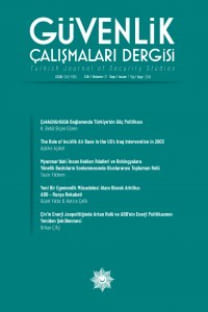Karma Güvenlik İkilemi ve Devlet Dışı Silahlı Aktörlerin Uluslararası Sistemdeki Rolü
Karma Güvenlik İkilemi, Uluslararası Sistem, Devlet Dışı Silahlı Aktörler
___
- Aydınlı, E., (2016). Violent Non-State Actors: From Anarchists to Jihadists. Abington: Routledge
- Acun, C. ve Keskin. B., (2017). PKK’nın Kuzey Suriye Örgütlenmesi PYD/YPG, Ankara: SETA Rapor, s.s. 9-48
- Buzan, B., Waever, O. ve Wilde, J., (1998). Security: A New Framework for Analysis. Londra: Lynne Rienner Publishers, 1-144
- Creveld, M. Van., (2008). The Changing Face of War: Combat from the Mane to Iraq. New York: Ballantine Press, s.s. 219-221
- Dal, Emel P., (2017). Impact of the transnationalization of the Syrian civil war on Turkey: conflict spillover cases of ISIS and PYD-YPG/ PKK. Cambridge Review of International Affairs, 29(4), s. 1-3
- Duran, B. ve Yeşiltaş. M., (2018). Ortadoğu’da Devlet Dışı Silahlı Aktörler: Terör Örgütleri, Milisler ve Vekil Güçler, Ankara: SETA Yayınları, s.s. 9-10
- David, S. R., (1997). Internal War: Causes and Cures. World Politics, 49(1), s. 554-555.
- Gaub, F., (2017). State Vacuums and Non-State Actors in the Middle East and North Africa. Lorenzo Kamel (ed.), The Frailty of Authority Borders, Non-State Actors and Power Vacuums in a Changing Middle East (içinde). Roma: Edizioni Nuova Cultura
- Gürler, Recep. T. ve. Özdemir, Ömer B., (2014). El-Kaide’den Post El-Kaide’ye: IŞİD. Türkiye Ortadoğu Çalışmaları Dergisi,, 1(1), s. 115-120.
- Jervis, R. ve Snyder. J., (1999). Civil War and the Security Dilemma. Barbara F. Walter ve Jack Snyder (ed.), Civil Wars, Insecurity and Intervention (içinde). New York: Columbia University Press, s. 19-23
- Jones, S. G., (2014). A Persistent Threat: The Evolution of al Qa’ida and Other Salafi Jihadists. RAND Corporation, s. 13.
- Karagöl, Erdal T., (2014). Enerji Denkleminde Beklenmeyen Değişken: IŞİD, Haziran, Sayı: 54, s. 1-4.
- Kerman, İ. v. Efegil. E., (2017). Terör Örgütü PKK/PYD’nin Suriye’de İzlediği İç Savaş Stratejisinin Değerlendirilmesi. ANKASAM Uluslararası Kriz ve Siyaset Araştırmaları Dergisi, 1(2), . 162-198
- Kreause, K. ve Milliken. J., (2009). Introduction: The Challenge of Non-State Armed Groups. Contemporary Security Policy, 30(2), s. 204.
- Kuausch, K., (2017). Proxy Agents: State and Non-State Alliences in the Middle East. The International Spectator, s. 78-82.
- Mearsheimer, John. J., (2007). Structure Realism. Tim Dunne, Milja Kurki ve Steve Smith (ed.), International Relations Theories: Dicipline and Diversity (içinde), Oxford University Press.
- Mearsheimer, John J., (2018). The Graet Delusion: Liberal Dreams and International Realities. New Haven ve Londra: Yale Unisversity Press.
- Oktav, Özden Z., Dal, Emel P. ve Kurşun, Ali M., (2017). Reframing and Reassessing the VNSAs in Syrian Conflict: An Introduction. Zeynep Özden Oktav, Emel Parlar Dal ve Ali Murat Kurşun (ed.). Violent Non-state Actors and the Syrian Civil War (içinde). Cham: Springer, s.s. 5-11.
- Ould Mohamedou, Mohammad M., (2009). Al Qaeda: From the Near to the Far Enemy and Back (1988-2008). Klejda Mulaj (ed.), Violent Non-State Actors in World Politics (içinde). Londra: Hurst Publishers.
- Phillips, C., (2016). The Battle for Syria: International Rivalry in the New Middle East. New Haven CT: Yale University Press.
- Phillips, A., (2014). The Islamic State’s challenge to international order. Australian Journal of International Affairs, 68(5), s.s. 497-499.
- Podder, S., (2013). Non-State Armed Groups and Stability: Reconsidering Legitimacy and Inclusion. Contemporary Security Policy, 34(1), s. 31.
- Salloukh, Bassel F., (2017). Overlapping Contests and Middle East International Relations: The Return of the Weak Arab State. American Political Science Association, s. 661.
- Posen, Barry. R., (1993). The Security Dilemma and Ethnic Conflict. Michael E. Brown (ed.). Ethnic Conflict and International Security (içinde). Princeton: Princeton University Press
- Vinci, A., (2008). Anarchy, Failed States, and Armed Groups: Reconsidering Conventional Analysis. International Security Quarterly, Sayı: 52, s. 300-314.
- Yossef, A. ve. Joseph. C., (2015). Inward-Directed Security. Amr Yossef ve Joseph. Cerami (ed.). The Arap Spring and Geopolitics of The Middle East: Emerging Security Threats and Revolutionary Change (içinde). Londra: Palgrave Macmillan, s. 27.
- Williams, P., (2008). Violent Non-State Actors and National and Internatinal Security. ETH Zurich,, s.s. 9-15.
- Zohar, E., (2015). A New Typology of Contemporary Armed Non-State-Actors: Interpreting The Diversity. Studies in Conflict & Terrorism, s. 5.
- ISSN: 2148-6166
- Yayın Aralığı: 2
- Başlangıç: 2000
- Yayıncı: Polis Akademisi Başkanlığı
Yumuşak Güç Bağlamında Sadr Hareketi’nin Irak Siyasetinde Zirveye Yükselişi
Dağlık Karabağ Meselesi: Bölgesel Güvenlik Dinamikleri Üzerine Bir Değerlendirme
Destined for War: Can Amerıca and China Escape Thucydides’ Trap
Post-Sovyet Dönemde Güney Kafkasya’da Güvenlik: Başlıca Gelişmeler ve Çatışma Ortamının Dönüşümü
Muhammet Faruk ÇAKIR, Oğuzhan ATAMAN
BOOK REVIEW: Destined for War: Can America and China Escape Thucydides' Trap
BOOK REVIEW: Destined for War: Can America and China Escape Thucydides' Trap
Akıllı Güç Bağlamında Sadr Hareketi’nin Irak SiyasetindeZirveye Yükselişi
Karma Güvenlik İkilemi ve Devlet Dışı Silahlı Aktörlerin Uluslararası Sistemdeki Rolü
